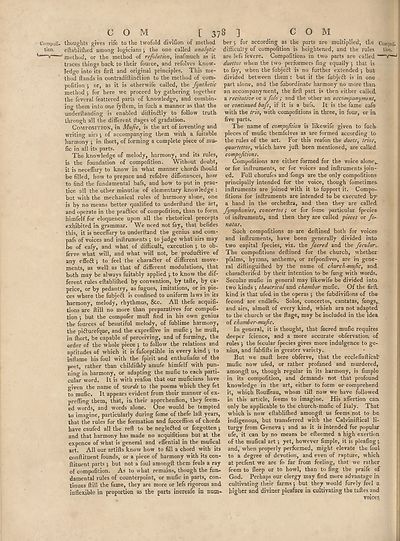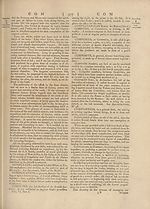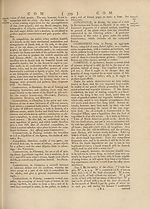Encyclopaedia Britannica, or, a Dictionary of arts, sciences, and miscellaneous literature : enlarged and improved. Illustrated with nearly six hundred engravings > Volume 6, CHI-Crystallization
(400) Page 378
Download files
Complete book:
Individual page:
Thumbnail gallery: Grid view | List view

COM [ 378 3 COM
Compofi- thoughts gives rife to the twofold divifion of method
tion. eftablilhed among logicians j the one called analytic
“ method, or the method of refolutioriy inafmuch as it
traces things back to their fourcer and refolves know¬
ledge into its firft and original principles. This me¬
thod (lands in contradillinftion to the method of com-
pofition ; or, as it is otherwife called, the fynthetic
method j for here we proceed by gathering together
the feveral feattered parts of knowledge, and combin¬
ing them into one fyftem, in fuch a manner as that the
underftanding is enabled diftinflly to follow truth
through all the different tlages of gradation.
Composition, in Mufcc, is the art of inventing and
writing airs ; of accompanying them with a luitable
harmony ; in fhort, of forming a complete piece of mur
lie in all its parts.
The knowledge of melody, harmony, and its rules,
is the foundation of compofition^ Without doubt,
it is neceffary to know in what manner chords (hould
be filled, how to prepare and refolve diffonances, how
to find the fundamental bafs, and how to put in prac¬
tice all the other minutiae of elementary knowledge :
but with the mechanical rules of harmony alone, one
is by no means better qualified to underhand the art,
and operate in the pra£lice of compofition, than to form
himfelf for eloquence upon all the rhetorical precepts
exhibited in grammar. We need not fay, that beiides
this, it is necelfary to underftand the genius and com-
pafs of voices and inftruments ; to judge what airs may
be of eafy, and what of difficult, execution ; to ob-
ferve what will, and what will not, be produdlive of
any effedl j to feel the charadler of different move¬
ments, as well as that of different modulations, that
both may be always fuitably applied yto know the dif¬
ferent rules eftabliffied by convention, by tafte, by ca¬
price, or by pedantry, as fugues, imitations, or in pie¬
ces where the fubjedl is confined to uniform laws in its
harmony, melody, rhythmus, &c. All thefe acquifi-
tions are dill no more than preparatives for compofi¬
tion •, but the compofer muff find in his own genius
the fources of beautiful melody, of fublime harmony,
the pidlurefque, and the expreffive in mufic j he muff,
in (hurt, be capable of perceiving, and of forming, the
order of the whole piece ; to follow the relations and
aptitudes of which it is fufceptible in every kind •, to
inflame his foul with the fpirit and enthufiafm of the
poet, rather than childifely amufe himfelf with pun¬
ning in harmony, or adapting the mufic to each parti¬
cular word. It is with reafon that our muficians have
given the name of words to the poems which they fet
to mufic. It appears evident from their manner of ex-
preffing them, that, ia their apprehenfion, they feem-
ed words, and words alone. One would be tempted
to imagine, particularly during fome of thefe lad years,
that the rules for the formation and fucceffion of chords
have caufed all the red to be negk&ed or forgotten \
and that harmony has made no acquifitions but at the
expence of what is general and effential in the mufical
art. All our artids know how to fill a chord with its
condituent founds, or a piece of harmony with its con-
dituent parts j but not a foul amongd them feels a ray
of compofition. As to what remains, though the fun¬
damental rules of counterpoint, or mufic in parts, con¬
tinues dill the fame, they are more or lefs rigorous and
inflexible in proportion as the parts increafe in num¬
ber •, for according as the parts are multiplied, the Com-!cfi.
difficulty of compofition is heightened, and the rules tion.
are lefs fevere. Compofitions in two parts are called
duettos when the two performers fing equally 5 that is
to fay, when the fubjeft is no further extended ; but
divided between them : but it the fubjedl is in one
part alone, and the fubordinate harmony no more than-
an accompanyment, the firft part is then either called,
a recitative or a folo ; and the other an accompamjmtnt,
or continued bafs, if it is a bafs. It is the fame cafe
with the trio, with compofitions in three, in four, or in
five parts.
The name of compojition is likewife given to fuch
pieces of mufic themfelves as are formed according to
the rules of the art. For this reafon the duets, trios,
quartettos, which, have juft been mentioned, are called
compofitions.
Compofitions are either formed for the voice alonev
or for inftruraents, or for voices and inftruments join¬
ed. Full chorufes and fongs are the only compofitions
principally intended for the voice, though fometimes-
inftruments are joined with it to fupport it. Compo¬
fitions for inftruments are intended to be executed by
a band in the orcheftra, and then they are called
fymphonies, concertos; or for fome particular fpeciea
of inftruments, and then they are called pieces or fo*
natas.
Such compofitions as are deftined both for voices
and inftruments, have been generally divided into
two capital fpecies, viz. the faered and the fecular.
The compofitions deftined for the church, whether
pfalms, hymns, anthems, or refponfives, are in gene¬
ral diftinguiffied by the name of church-mufic, and
charadterifed by their intention to be fung with words.
Secular mufic in general may likewife be divided into
two kinds ; theatrical and chamber mufic. Of the firft.
kind is that ufed in the operas j the fubdivifions of the
fecond are endlefs. Solos, concertos, cantatas, fongs,.
and airs, almoft of every kind, which ara not adapted,
to the church or the ftage, may be included in the idea
of chamber-mufc.
In general, it is thought, that (acred mufic requires
deeper fcience, and a more accurate obfervatioa of
rules 5 the fecular fpecies gives more indulgence to ge¬
nius, and fubfifts in greater variety.
But we mud here obftrve, that the ecclefiaftical*
mufic now ufed, or rather profaned and murdered,
amongft us, though regular in its harmony, is Ample
in its eompofition, and demands not that profound
knowledge in the art, either to form or comprehend
it, which Rouffeau, whom till now we have followed
in this article, feems to imagine. His affertion caa
only be applicable to the church-mufic of Italy. That
which is now eftabliffied amongft us feems not to be
indigenous, but transferred with the Calviniftical li¬
turgy from Geneva ; and as it is intended for popular
ufe, it can by no means be efteemed a high exertion
of the mufical art ; yet, however fimple, it is pleafing j
and, when properly performed, might elevate the foul
to a degree of devotion, and even of rapture, which
at prefent we are fo far from feeling, that we rather
feem to deep or to howl, than to fing the praife of
God. Perhaps our clergy may find more advantage in
cultivating their farms *, but they would furely feel a
higher and diviner pleafure in cultivating the taftes and
voices
Compofi- thoughts gives rife to the twofold divifion of method
tion. eftablilhed among logicians j the one called analytic
“ method, or the method of refolutioriy inafmuch as it
traces things back to their fourcer and refolves know¬
ledge into its firft and original principles. This me¬
thod (lands in contradillinftion to the method of com-
pofition ; or, as it is otherwife called, the fynthetic
method j for here we proceed by gathering together
the feveral feattered parts of knowledge, and combin¬
ing them into one fyftem, in fuch a manner as that the
underftanding is enabled diftinflly to follow truth
through all the different tlages of gradation.
Composition, in Mufcc, is the art of inventing and
writing airs ; of accompanying them with a luitable
harmony ; in fhort, of forming a complete piece of mur
lie in all its parts.
The knowledge of melody, harmony, and its rules,
is the foundation of compofition^ Without doubt,
it is neceffary to know in what manner chords (hould
be filled, how to prepare and refolve diffonances, how
to find the fundamental bafs, and how to put in prac¬
tice all the other minutiae of elementary knowledge :
but with the mechanical rules of harmony alone, one
is by no means better qualified to underhand the art,
and operate in the pra£lice of compofition, than to form
himfelf for eloquence upon all the rhetorical precepts
exhibited in grammar. We need not fay, that beiides
this, it is necelfary to underftand the genius and com-
pafs of voices and inftruments ; to judge what airs may
be of eafy, and what of difficult, execution ; to ob-
ferve what will, and what will not, be produdlive of
any effedl j to feel the charadler of different move¬
ments, as well as that of different modulations, that
both may be always fuitably applied yto know the dif¬
ferent rules eftabliffied by convention, by tafte, by ca¬
price, or by pedantry, as fugues, imitations, or in pie¬
ces where the fubjedl is confined to uniform laws in its
harmony, melody, rhythmus, &c. All thefe acquifi-
tions are dill no more than preparatives for compofi¬
tion •, but the compofer muff find in his own genius
the fources of beautiful melody, of fublime harmony,
the pidlurefque, and the expreffive in mufic j he muff,
in (hurt, be capable of perceiving, and of forming, the
order of the whole piece ; to follow the relations and
aptitudes of which it is fufceptible in every kind •, to
inflame his foul with the fpirit and enthufiafm of the
poet, rather than childifely amufe himfelf with pun¬
ning in harmony, or adapting the mufic to each parti¬
cular word. It is with reafon that our muficians have
given the name of words to the poems which they fet
to mufic. It appears evident from their manner of ex-
preffing them, that, ia their apprehenfion, they feem-
ed words, and words alone. One would be tempted
to imagine, particularly during fome of thefe lad years,
that the rules for the formation and fucceffion of chords
have caufed all the red to be negk&ed or forgotten \
and that harmony has made no acquifitions but at the
expence of what is general and effential in the mufical
art. All our artids know how to fill a chord with its
condituent founds, or a piece of harmony with its con-
dituent parts j but not a foul amongd them feels a ray
of compofition. As to what remains, though the fun¬
damental rules of counterpoint, or mufic in parts, con¬
tinues dill the fame, they are more or lefs rigorous and
inflexible in proportion as the parts increafe in num¬
ber •, for according as the parts are multiplied, the Com-!cfi.
difficulty of compofition is heightened, and the rules tion.
are lefs fevere. Compofitions in two parts are called
duettos when the two performers fing equally 5 that is
to fay, when the fubjeft is no further extended ; but
divided between them : but it the fubjedl is in one
part alone, and the fubordinate harmony no more than-
an accompanyment, the firft part is then either called,
a recitative or a folo ; and the other an accompamjmtnt,
or continued bafs, if it is a bafs. It is the fame cafe
with the trio, with compofitions in three, in four, or in
five parts.
The name of compojition is likewife given to fuch
pieces of mufic themfelves as are formed according to
the rules of the art. For this reafon the duets, trios,
quartettos, which, have juft been mentioned, are called
compofitions.
Compofitions are either formed for the voice alonev
or for inftruraents, or for voices and inftruments join¬
ed. Full chorufes and fongs are the only compofitions
principally intended for the voice, though fometimes-
inftruments are joined with it to fupport it. Compo¬
fitions for inftruments are intended to be executed by
a band in the orcheftra, and then they are called
fymphonies, concertos; or for fome particular fpeciea
of inftruments, and then they are called pieces or fo*
natas.
Such compofitions as are deftined both for voices
and inftruments, have been generally divided into
two capital fpecies, viz. the faered and the fecular.
The compofitions deftined for the church, whether
pfalms, hymns, anthems, or refponfives, are in gene¬
ral diftinguiffied by the name of church-mufic, and
charadterifed by their intention to be fung with words.
Secular mufic in general may likewife be divided into
two kinds ; theatrical and chamber mufic. Of the firft.
kind is that ufed in the operas j the fubdivifions of the
fecond are endlefs. Solos, concertos, cantatas, fongs,.
and airs, almoft of every kind, which ara not adapted,
to the church or the ftage, may be included in the idea
of chamber-mufc.
In general, it is thought, that (acred mufic requires
deeper fcience, and a more accurate obfervatioa of
rules 5 the fecular fpecies gives more indulgence to ge¬
nius, and fubfifts in greater variety.
But we mud here obftrve, that the ecclefiaftical*
mufic now ufed, or rather profaned and murdered,
amongft us, though regular in its harmony, is Ample
in its eompofition, and demands not that profound
knowledge in the art, either to form or comprehend
it, which Rouffeau, whom till now we have followed
in this article, feems to imagine. His affertion caa
only be applicable to the church-mufic of Italy. That
which is now eftabliffied amongft us feems not to be
indigenous, but transferred with the Calviniftical li¬
turgy from Geneva ; and as it is intended for popular
ufe, it can by no means be efteemed a high exertion
of the mufical art ; yet, however fimple, it is pleafing j
and, when properly performed, might elevate the foul
to a degree of devotion, and even of rapture, which
at prefent we are fo far from feeling, that we rather
feem to deep or to howl, than to fing the praife of
God. Perhaps our clergy may find more advantage in
cultivating their farms *, but they would furely feel a
higher and diviner pleafure in cultivating the taftes and
voices
Set display mode to:
![]() Universal Viewer |
Universal Viewer | ![]() Mirador |
Large image | Transcription
Mirador |
Large image | Transcription
Images and transcriptions on this page, including medium image downloads, may be used under the Creative Commons Attribution 4.0 International Licence unless otherwise stated. ![]()
| Permanent URL | https://digital.nls.uk/193012623 |
|---|
| Attribution and copyright: |
|
|---|
| Description | Ten editions of 'Encyclopaedia Britannica', issued from 1768-1903, in 231 volumes. Originally issued in 100 weekly parts (3 volumes) between 1768 and 1771 by publishers: Colin Macfarquhar and Andrew Bell (Edinburgh); editor: William Smellie: engraver: Andrew Bell. Expanded editions in the 19th century featured more volumes and contributions from leading experts in their fields. Managed and published in Edinburgh up to the 9th edition (25 volumes, from 1875-1889); the 10th edition (1902-1903) re-issued the 9th edition, with 11 supplementary volumes. |
|---|---|
| Additional NLS resources: |
|

